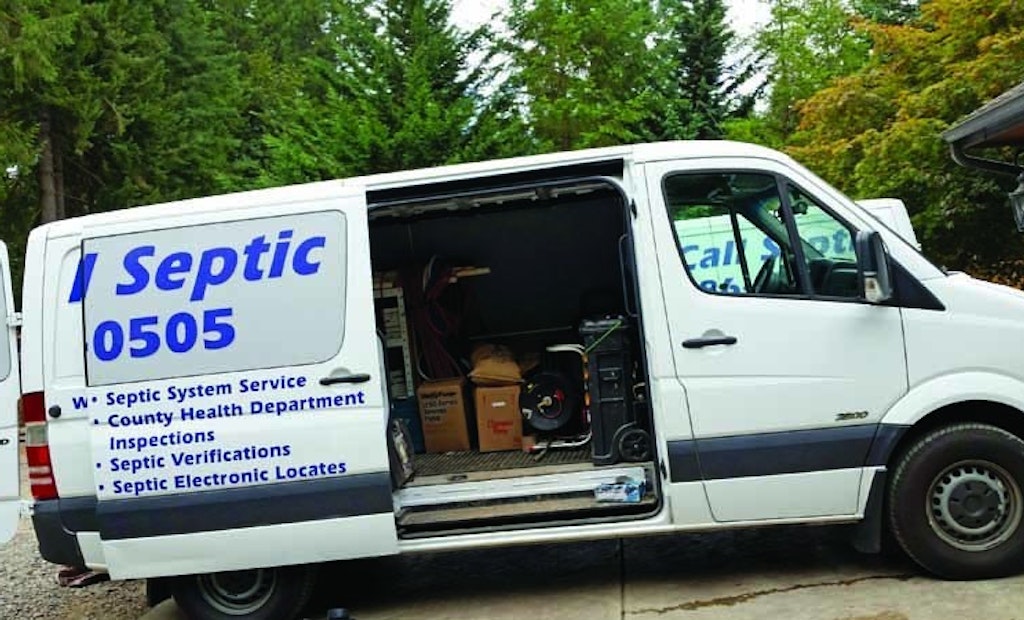Interested in Accessories?
Get Accessories articles, news and videos right in your inbox! Sign up now.
Accessories + Get AlertsYes, that sporty pickup truck is fun to drive and carries most of what you need. And a trailer adds lockable security. But what about those late-night or weekend calls when a septic overflows? You rush to the job, only to find you need a special fitting, pump or switch. It’s pouring rain, freezing sleet. You know that part is somewhere in your truck – but where?
Ronnie Tamez, 40, owner of First Call Septic Services in Battle Ground, Washington, says he wouldn’t think of leaving the yard without Hanz or Franz, the 2006 Freightliner 2500 Sprinter vans he has outfitted for every possible emergency.
You might wonder why someone who services septic systems needs a cargo van. It’s a question Tamez gets asked a lot by pumpers and
onsite installers.
“Well, I have to show up for an alarm call,” he says. “A high-water alarm or a low-air alarm; a UV light went out. I’m not going to show up in a vacuum truck that gets 2 miles to the gallon. You can’t carry a $150 light bulb in a vacuum truck, you’ll break it.”
Tamez says he looked at other vans before purchasing the two used Sprinters powered by Mercedes-Benz turbo-diesel V6 engines, but they didn’t have the features he was most interested in.
Fuel efficiency
“I wanted to be sure the truck was going to last, but also get really good mileage,” he says. “We own a Mercedes-Benz R350 with the same engine, so I already know how to work on it.”
That’s quite a stretch from the Honda Accord Tamez first used to make calls.
“I had to fold the seat down, put parts down. Every night when I got home I’d back up to the garage, pull everything out and it was back to the family car,” he says.
That was about 10 years ago.
Tamez also had a Chevy 1-ton, but while the Honda got 26 mpg, the Chevy pickup with 454 engine got about 6 to 9 miles a gallon, even when it was empty. In his quest for better fuel mileage, Tamez purchased a Saturn station wagon, which he ran for two years. Needing more room for inventory, Tamez added a Ford F-250 pickup with canopy topper, which he still owns.
Access to parts and equipment
“Everything was organized,” he says. “I knew where everything was in the back of the pickup, but I always seemed to need the piece of equipment that was all the way in the back, like the jetting equipment or something. I’d have to empty out half my tools. Or my control switches that were in the far left corner – I was always lying on top of my tools to get the control switches out.”
Two years of hunting and pecking along with hiring his first employee convinced Tamez that a better solution was needed.
“For me to go through the tools is one thing, but it’s another thing to have an employee do it,” says Tamez, who now has two technicians and a third in training. “In 2013, we went out and bought the first Sprinter van to see how we liked it.”
Tamez had RC Display Vans in Portland, Oregon, install three rows of 7-foot-long by 1 1/2-foot-deep Weather Guard shelving and LED lights in the rear for night work.
One set of shelves is designated for fittings, bushings and adapters. Tamez also carries check valves, check gates, ultraviolet disinfection devices, indoor and outdoor alarm panels, control panels, blowers, and pumps common to the area. Strapped inside is a 3-foot-tall toolbox fitted with screwdrivers, volt meters, drill bits, large wrenches, fuses and light bulbs that can be rolled where needed.
Weather protection
Living in the Northwest, rain can be a daily occurrence. Working out of a pickup, Tamez would put his rain suit on outdoors, finish the job, throw it in the back of the pickup and run to the cab.
“Your suit wouldn’t really dry out until summer,” he says. “Now I can hang it up.”
Tamez also looked at mechanics trucks, but like the pickup, equipment was susceptible to weather. He also appreciates the organization the
van provides.
“I figure when we pull up people don’t want to be paying me to move tools around. Just like if you took your car to a mechanic – if you’re going to pay the guy $120 an hour, you don’t want him looking for a screwdriver; he needs to walk right up and grab it.”
Tamez also has a 24-foot trailer, but says it’s too big for most jobs.
Looking back, Tamez says if he had to do it over, he would buy a 1-ton van with a longer bed.
“It’s a little cramped in there,” he says. “I’ve added a lot of stuff since we bought the vans. We have the jetting equipment back there. This summer I got tired of swinging pig bars and pickaxes and bought a Makita jackhammer. That’s a big piece of equipment. So we’re starting to outgrow the vans a little bit.”









